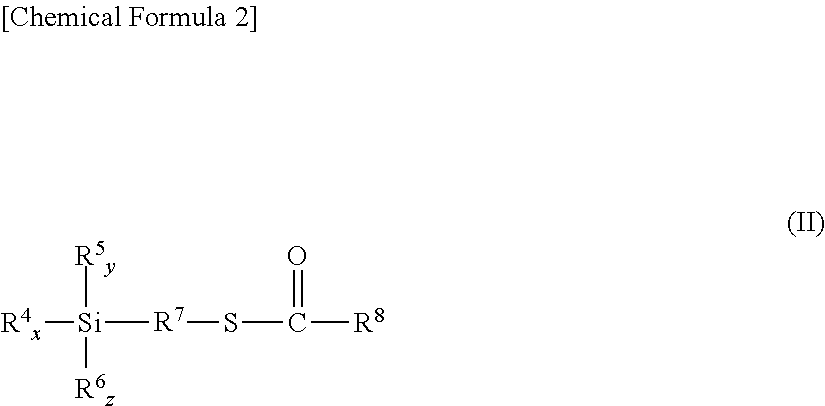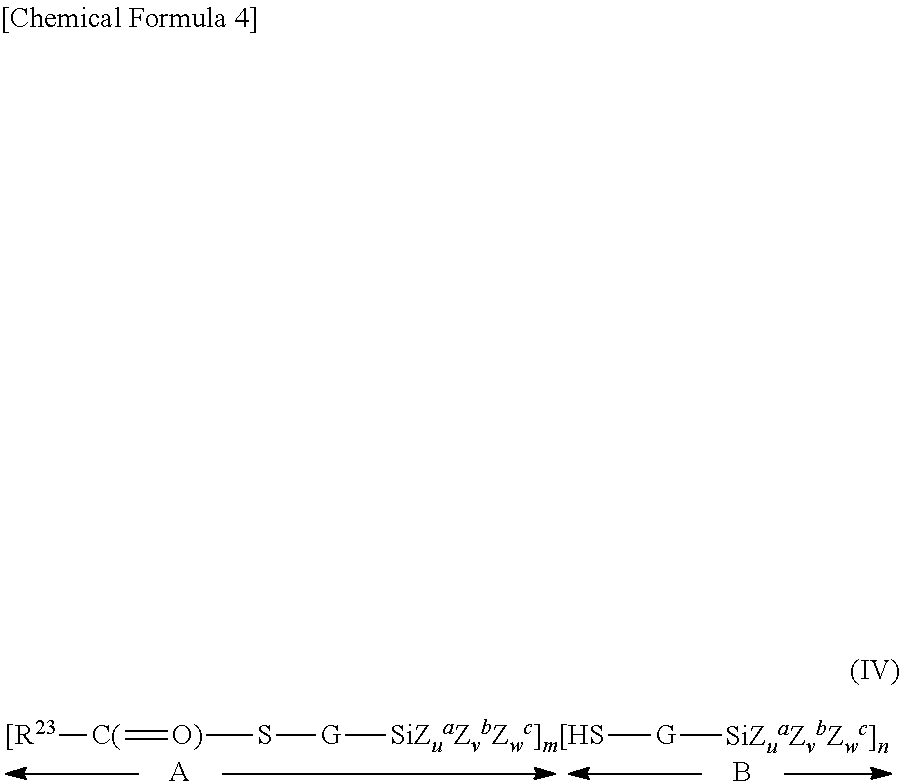Method for manufacturing rubber composition
a technology of rubber composition and composition, which is applied in the direction of film/foil adhesives, synthetic resin layered products, tyre parts, etc., can solve the problems of not taking into account the kneading conditions, and achieve the effect of increasing the coupling function of silane coupling agents and excellent low heat generation properties
- Summary
- Abstract
- Description
- Claims
- Application Information
AI Technical Summary
Benefits of technology
Problems solved by technology
Method used
Image
Examples
production example 1
Production of Silane Coupling Agent Represented by Average Compositional Formula (CH3CH2O)3Si—(CH2)3—S—(CH2)6—S2.5—(CH2)6—S—(CH2)3—Si(OCH2CH3)3
[0148]119 g (0.5 mol) of 3-mercaptopropyltriethoxysilane was put into a 2-liter separable flask equipped with a nitrogen-introducing duct, a thermometer, a Dimroth condenser and a dropping funnel, and with stirring, 151.2 g (0.45 mol) of an ethanol solution of sodium ethoxide having an effective ingredient concentration of 20% by mass was added thereto. Subsequently, this was heated up to 80° C. and stirred for 3 hours. Afterwards, this was cooled and transferred into a dropping funnel.
[0149]Next, 69.75 g (0.45 mol) of 1,6-dichlorohexane was put into the same separable flask as above, heated up to 80° C., and the reaction product of 3-mercaptopropyltriethoxysilane and sodium ethoxide was slowly and dropwise added thereto. After the addition, this was stirred for 5 hours at 80° C. Subsequently, this was cooled, and salt was separated from the...
examples 15 to 21
, and Comparative Examples 8 to 14
[0155]According to the compositional formulation and the kneading method shown in Table 3, the ingredients were kneaded in a Banbury mixer in such a controlled manner that, after addition of the rubber component, silica, the silane coupling agent and others in the first stage of kneading, the time (second) before addition of 1,3-diphenylguanidine and the temperature (° C.) of the rubber composition at addition of 1,3-diphenylguanidine could be as in Table 3, or in the first stage of kneading, 1,3-diphenylguanidine was not added and the ingredients were kneaded in the Banbury mixer, thereby preparing 14 types of rubber compositions. The obtained, 14 rubber compositions were evaluated in point of the low-heat-generation property (tan δ index) thereof according to the above-mentioned method. The results are shown in Table 3.
TABLE 3ExampleComparative Examplepart by mass15161718192021891011121314FormulationFirst StageEmulsion-Polymerized75502580—80—75502...
examples 22 to 29
, and Comparative Examples 15 to 18
[0156]According to the compositional formulation and the kneading method shown in Table 4, the ingredients were kneaded in a Banbury mixer in such a controlled manner that, after addition of the rubber component, silica, the silane coupling agent and others in the first stage of kneading, the time (second) before addition of 1,3-diphenylguanidine and the temperature (° C.) of the rubber composition at addition of 1,3-diphenylguanidine could be as in Table 4, or in the first stage of kneading, 1,3-diphenylguanidine was not added and the ingredients were kneaded in the Banbury mixer, thereby preparing 12 types of rubber compositions. The obtained, 12 rubber compositions were evaluated in point of the low-heat-generation property (tan δ index) thereof according to the above-mentioned method. The results are shown in Table 4.
TABLE 4Examplepart by mass222324252627FormulationFirst StageEmulsion-Polymerized SBR-C *1368.7568.7568.7568.7568.7568.75of Kneadi...
PUM
| Property | Measurement | Unit |
|---|---|---|
| temperature | aaaaa | aaaaa |
| time | aaaaa | aaaaa |
| time | aaaaa | aaaaa |
Abstract
Description
Claims
Application Information
 Login to View More
Login to View More - R&D
- Intellectual Property
- Life Sciences
- Materials
- Tech Scout
- Unparalleled Data Quality
- Higher Quality Content
- 60% Fewer Hallucinations
Browse by: Latest US Patents, China's latest patents, Technical Efficacy Thesaurus, Application Domain, Technology Topic, Popular Technical Reports.
© 2025 PatSnap. All rights reserved.Legal|Privacy policy|Modern Slavery Act Transparency Statement|Sitemap|About US| Contact US: help@patsnap.com



